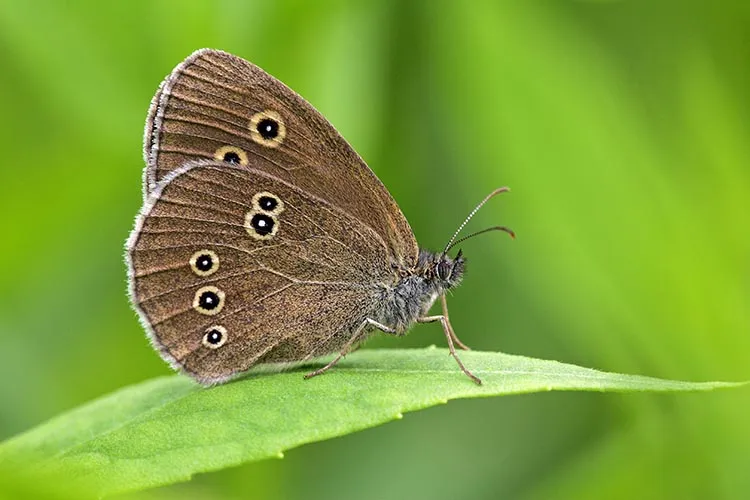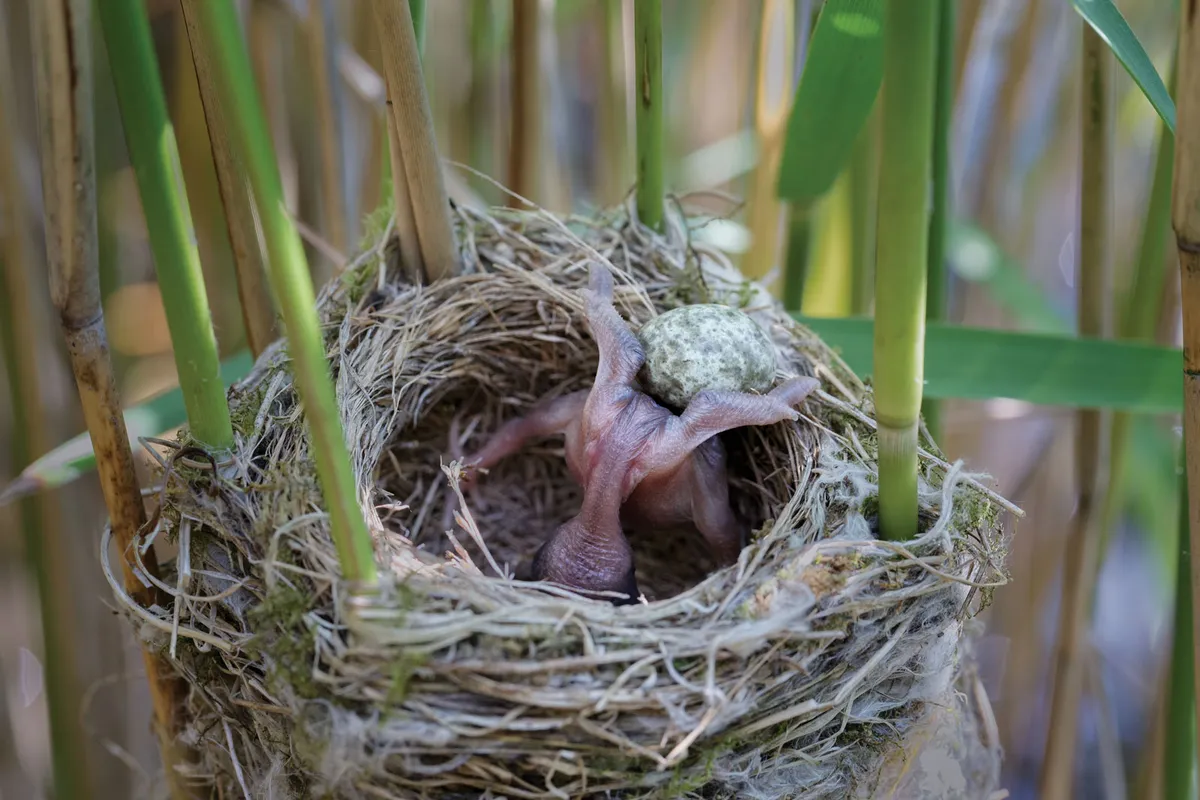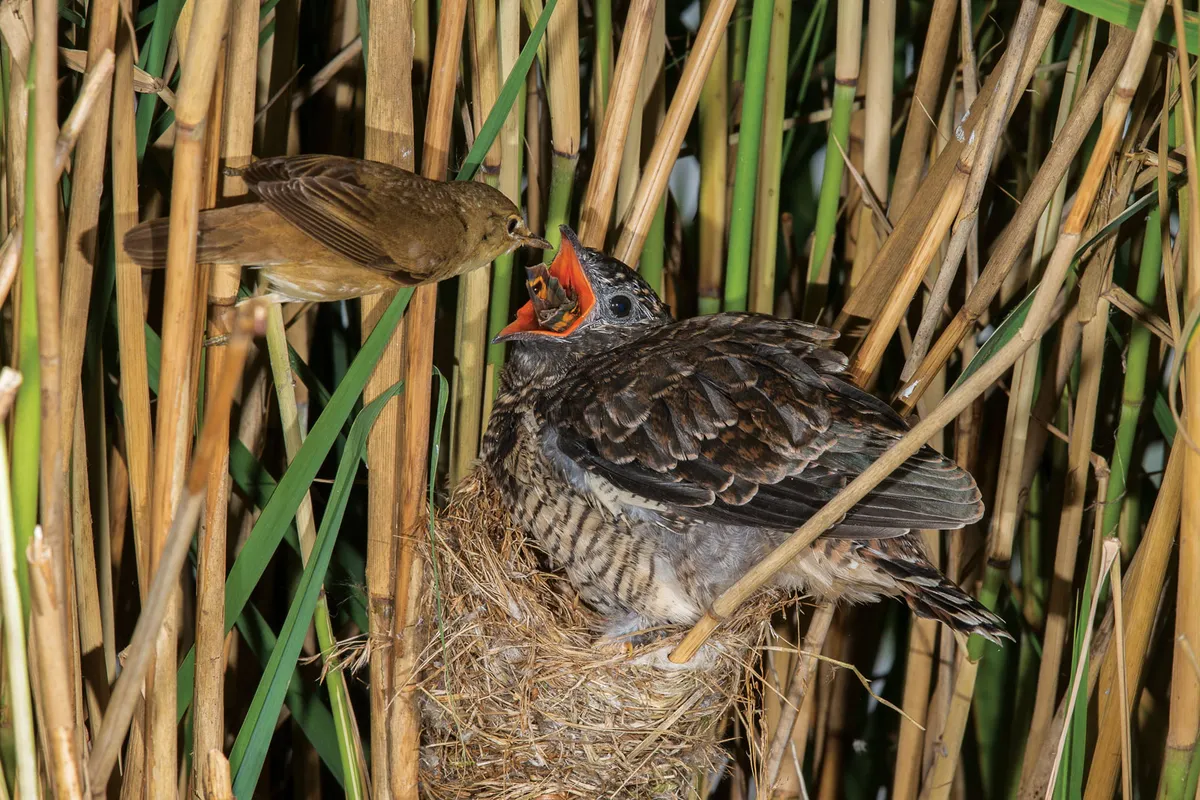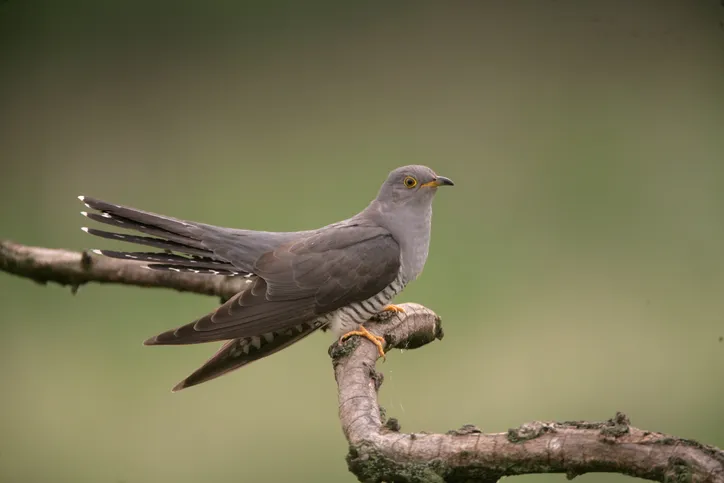Learn more about the cuckoo, including why cuckoos lay their eggs in other nests, cuckoo facts, why the species is in decline and the best places to still see them in the UK, in our expert guide.
Cuckoo facts
- Common cuckoos breed right across the temperate Old World, from Western Europe to Japan
- There are currently 15,000 breeding pairs of common cuckoo in the UK
- This solitary bird eats insects, and is particularly fond of hairy caterpillars
- There are many distinct races of cuckoo. Each specialises in a particular host species, and lays a distinctive egg type
- Most races lay an egg that matches the egg of their chosen host. Experiments with model eggs reveal that these hosts reject eggs unlike their own, so the good match is necessary to trick the hosts.
- A female common cuckoo can lay up to 25 eggs in a summer
- If she fails to find a nest of her favourite host, as a last resort she might lay in the nest of another host species, but this egg is more likely to be rejected, as it will not be such a good match to the host egg
Related articles

Why is the cuckoo in decline?
But this once-familiar voice is now disappearing from the British countryside, and the silence is a stark reminder of our diminishing natural world. What has caused this precipitous decline? Loss of natural habitat and scarcer insect food are likely to have played a part, but cuckoos are now also facing increasing problems on migration to Africa.
Only in the past decade have we learnt exactly where our cuckoos go in winter. Despite 90 years of ringing, just one recovery south of the Sahara had ever been produced; a cuckoo ringed as a chick in Eton on 23 June 1928 was felled by bow and arrow in Cameroon, West Africa, on 30 January 1930. We know this because the hunter gave the ring to his wife to wear as an ornament in her nose. Thus it came to the notice of the local pastor at church, who reported the ring number to the British Museum.
Where do cuckoos go in winter?
Now, satellite tracking by the British Trust for Ornithology, led by Chris Hewson and Phil Atkinson, has revealed that our cuckoos winter in the forests of the Congo. Cuckoos migrate mainly by night, and often at high altitude, between three and five kilometres above the ground, perhaps to find strong following winds to help them on their way. They cross the Sahara in one 50-60 hour continuous flight. Imagine them launching into the night skies at dusk. They then fly nonstop through that night and all the following day, then another night and day, and finally a third night, before they have the chance to feed once more.
The migration route varies, and this provides the clue to the varying fortunes of our summer cuckoos. In autumn, most English cuckoos go southwest through Spain, but increasing droughts in SW Europe have made it difficult for them to put on sufficient fat reserves and only half of the tracked birds survive the long desert crossing. This heavy mortality on migration matches the dramatic decline in our English breeding cuckoos; we have lost two-thirds of them in the last 30 years. By contrast, most Scottish and Welsh cuckoos take a different autumnal route, south-east through Italy. Here, feeding conditions seem much better, because more than 95% of these tracked cuckoos make it safely to winter quarters.
This is reflected in the better fate of their breeding populations; Welsh cuckoos have declined much less than in England, and in Scotland, numbers have remained stable.
Why does the cuckoo lay its eggs in another bird's nest?
As cuckoos disappear from the English countryside, we lose part of our cultural heritage. But the loss of an evolutionary treasure is surely more heartbreaking, for the cuckoo’s breeding behaviour is one of the wonders of the natural world. The cuckoo never raises its own offspring. Instead, it lays its eggs in the nests of other birds; just one egg in each host nest. Soon after the cuckoo chick hatches, it balances each of the host’s eggs on its back, one by one, and heaves them out of the nest. Any host chicks will get thrown out too. Once the cuckoo chick has claimed the nest to itself, the host parents are then tricked into raising a young cuckoo instead of a brood of their own.

The sight of a little warbler or pipit feeding an enormous cuckoo fledgling, six times the size of the foster parent, has astonished human observers for centuries. How does the cuckoo get away with such outrageous behaviour? In fact, cuckoos need extraordinary trickery to get past host defences, for the hosts are on the lookout for cuckoo eggs and if they detect one, they puncture it and eject it from the nest.
Two favourite hosts in Britain are reed warblers in marshland and meadow pipits in moorland. Individual female cuckoos specialise on one host species and there are genetically distinct cuckoo races. Reed-warbler-specialist cuckoos lay a greenish spotted egg, just like those of reed warblers, while meadow-pipit-specialist cuckoos lay a brownish spotted egg, just like those of meadow pipits. Both these hosts reject eggs unlike their own, so the specialised cuckoo-egg mimicry is essential to fool them.
The female cuckoo also needs secrecy to succeed, because if the hosts see her at their nest they are alerted to inspect their clutch more closely. She glides down to the host nest from a hidden lookout perch, removes a host egg, lays her own in its place, and is off – all within a 10-second visit. As she departs, she often gives a chuckle call, as if in triumph. This is perhaps the most remarkable trick of all. The chuckle is similar to the rapid call notes of a sparrowhawk, and it diverts the hosts’ attention away from noticing changes in their clutch and towards their own safety instead. So the female cuckoo has the last laugh as she flies away.

Given that hosts are on the lookout for odd eggs, it seems strange that they accept a cuckoo chick so different from their own. But the cuckoo chick has a special trick, too. Its loud and rapid begging calls sound like a whole brood of hungry host young, and this fools the foster parents into bringing as much food to a cuckoo chick as to a brood of their own.

Cuckoo chicks fledge from the host nest at around three weeks of age and are then fed for two more weeks before they become independent. They will never see their real parents; indeed, most adult cuckoos will already have left the UK by late June. With no more new host clutches to parasitise, their summer’s job is done and they set off on their long journey south to Africa. The young cuckoos will follow them a few weeks later and all alone, guided on their incredible journey by the night skies and the Earth’s magnetic field. Let’s hope some will make it safely back to our shores one day, as heralds of a new spring.
It’s a crime that has captivated nature lovers for centuries. In the 18th century, Edward Jenner first recorded a newly hatched cuckoo’s murderous rampage. Puzzled by the migratory cuckoo’s parasitical existence, he suggested that the adult birds simply didn’t have time to raise their young, needing to nip back to Africa as soon as possible. Around the same time, the famed naturalist Gilbert White guessed that the cuckoo’s substantial stomach meant that it couldn’t incubate its eggs. To White, the desertion of the eggs was a “monstrous outrage on maternal affection”.
But it was Charles Darwin who cut to the chase in 1859’s On the Origin of Species. He identified the immense benefit of being a brood parasite. Freed from parental duties, the cuckoo was able to lay many more eggs than its victims. However, Darwin’s observation prompts one question: if the cuckoo’s con is so effective, why aren’t more birds at it? Of all of British birds, only the common cuckoo (Cuculus canorus) goes to such extraordinary lengths, and worldwide only around 1 percent of all birds share its methods.
After 23 years studying the cuckoo’s sinister plans in Wicken Fen, Britain’s foremost expert on cuckoo behaviour, Dr Nicholas Davies of the University of Cambridge, is able to shed some light on the matter.
“Foisting your parental duties on somebody else may seem to be a wonderful thing to do,” he explains. “But over evolutionary time, the hosts fight back so that the poor cuckoo has to work incredibly hard to be lazy, simply because it has to overcome all of these defences. What we witness is a fantastic arms race between parasite and host.”
This titanic battle commences with that famous bird call. In May, the blue-grey male cuckoo arrives on our shores from Africa and booms out his distinctive ‘cuc-coo’, thereby establishing himself as God’s gift to the slightly browner female. Nature takes its course and the female’s work begins.
Watching and waiting
If you think you’re a good birdwatcher, you’ve nothing on the female cuckoo. Perching motionless in a tree she will lay in wait, monitoring the nests of her potential victims. When the host is away feeding, the cuckoo strikes, silently swooping into the empty nest and gobbling down one of the host’s eggs so that her own, which she speedily lays, is offered better incubation. Her job done she zooms off, never to see her offspring again. The entire operation takes just 10 seconds.
But why does she have to be so quick? Davies’s experiments hold the answer. With his team, he planted stuffed cuckoos near reed warblers’ nests. When the warblers spotted this threat they attacked the fake bird, and after it was removed they were more likely to check their clutch, rejecting eggs that they didn’t believe were theirs. It’s the same as when you suddenly decide to install a burglar alarm after you’ve heard about robberies in the area. If the hosts are alerted to the presence of a cuckoo they are more suspicious of the eggs in their nest. But if they are unaware, they will incubate the interloper in blissful ignorance. Recent research has also shown that if the cuckoo is discovered and mobbed by its victims, the resulting hullabaloo is more likely to bring the nest to the attention of predators, thereby putting the cuckoo’s precious egg in jeopardy. To ensure that they can trick the hosts, the cuckoo has evolved to produce eggs that perfectly mimic the host’s own. They specialise in one species and pass the ability down to their young.
Evolution in action
Over a period of two years, Davies added painted wooden eggs of various sizes and colours to reed warblers’ nests. If they were even slightly different to the bird’s own clutch they were pushed out of the nest. The experiment also highlighted another aspect of this battle. “Hosts that are targeted by cuckoos evolve less variation in their own eggs,” he explains.
“This makes very good sense. It’s easier to spot a strange egg if all of your eggs look the same. So the cuckoo had to develop an even better match.”
While this mimicry is fantastic, the real jaw-dropping moment comes when the chick is born. The cuckoo’s egg has a head start, requiring half-a-day’s less incubation than the host’s clutch, possibly due to the fact that newly laid cuckoo eggs contain partly developed embryos. The chick’s homicidal tendencies are just as developed, and within hours of hatching the blind and naked infant pushes any remaining eggs from the nest. If any other chicks have had the misfortune to have already hatched, they’re also barged out to fall to their death.
Alone in the nest, the cuckoo now has the sole attention of its foster parents, who will dart around to feed it, leaving them no time to breed again for the entire season.
But even if the host had been hoodwinked into incubating a perfectly matched egg, surely they notice that their baby is twice their size? Early in his research, Nicholas wondered if the chick’s immense proportions were the reason that the hosts were confused into feeding the chick, which eats about the same amount as four ravenous reed warblers. Yet when he replaced a cuckoo chick with a similarly sized blackbird, the reed warblers cut back on feeding. Then he twigged that while the mother cuckoo uses visual trickery, the baby uses aural.
“The cuckoo chick has this amazing begging call,” he says. “It sounds like a whole brood of hungry chicks. So we repeated the blackbird experiment, giving it a helping hand in the form of a little loudspeaker next to nest. Every time the blackbird begged, we played the cuckoo begging call through the speaker.” The effect was instantaneous; the reed warblers doubled their efforts to feed the chick.
As the chick gets older the intensity of its begging cry increases to make the hosts work harder, victims of what Darwin called “mistaken instinct”. The host is hard-wired to feed its hungry young, and so the con works. After 19 days the cuckoo is literally bursting from its nest and will still be supported by its poor foster parents for a further two weeks, before abandoning them to head to Africa.
So, we know how the cuckoo pulls off its dastardly plan, but still haven’t answered the question of why. Is it a cruel or evil bird? Of course not. This is just nature at work, and perhaps one of the best examples of Darwin’s survival of the fittest. The arms race will continue, with both sides evolving to protect themselves or deceive the other, but our fascination with the cuckoo will remain. After all, everyone loves a rogue.
Where to see cuckoos in Britain

With long, pointed wings, a long tail and barring underneath, the common cuckoo looks rather like a bird of prey. Only male cuckoos call “cuck-oo”. The bill is opened for the “cuck” and closed to form a sound chamber for the “oo”.
Good places to look out for them are:
- RSPB reserve Lakenheath Fen in Suffolk
- New Forest
- Dartmoor
- Cannock Chase in Staffordshire
- North York Moors
- Brecon Beacons
- Central Wales around Tregaron
- Western Highlands of Scotland
- Isle of Skye
- The Hebrides islands
History of the cuckoo
Summer is a-coming in, loudly sing cuckoo!” proclaims the oldest English song. For thousands of years, the loud, ringing “cuck-oo” call of the male common cuckoo has heralded the arrival of our spring.
This “wandering voice” is the source of many myths. To hear your first cuckoo before breakfast was just unlucky, but if you were still in bed it was a sure sign of impending illness (incentive to rise early). However, good fortune would come if you heard one while out walking, and a child born on the day of the first cuckoo in spring would be lucky for all its life.

We all sang along, too, as the calling marked the passing of summer:
“Cuckoo, cuckoo…
What do you do?
In April, I open my bill.
In May, I sing night and day.
In June, I change my tune.
In July, far, far, I fly.
In August, away! I must.”

